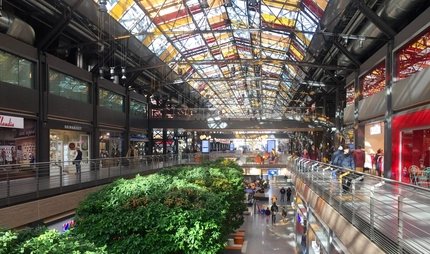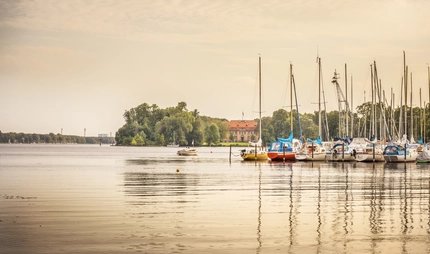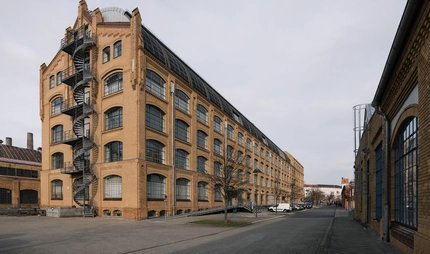
Borsigturm
Berlin's first high-rise building
Berlin in the 1920s was home to a wide variety of designs for spectacular high-rise buildings. The Borsigturm became reality.
The United States is the motherland of high-rise buildings. Even before the First World War, skyscrapers of over 200 metres in height were being built there and German architects wanted to emulate this example. Ludwig Mies van der Rohe's Wabe (honeycomb) entered into legend – a bold concept in 1921 for a twenty-storey office building at Friedrichstraße station. The design was never to be implemented.
Instead, from 1922 to 1924, the Borsigturm in Tegel was to be the first high-rise building constructed in Berlin. It was not a skyscraper like the American models, only reaching a height of 65 metres. But the work of the architect Eugen Schmohl is nevertheless a novelty of Berlin Modernism. Previously, towers weren't houses. Hans Hertlein's Wernerwerk tower in Siemensstadt (built in 1917), for example, is only the cladding for a chimney and water tank. But the Borsigturm is a real office building. This was where the administration of Borsig-Werke factory was located – at that time Europe's largest manufacturer of locomotives.
Symbol of industrial architecture
Within a short time, Schmohl's high-rise building became the landmark of the Borsig-Werke. The writer Franz Hessel wrote in the 1920s that the tower was a "proud, sharp-edged belfry of work".
In fact, the Borsigturm is both functional and representative. Since the inner walls are not load-bearing, the floor plans of the offices could be freely designed – from smaller units to open-plan offices filling the space of an entire floor. The weight of the tower rests partly on a steel skeleton construction. The façade is made of clinker, but unlike other steel constructions, the bricks are not cladding. To some extent, the brickwork bears the weight of the high-rise.
Schmohl planned nine floors above the base level for offices. He kept its outer façade functional. Here, the architect worked with groups of three: by means of three cornices he combined three storeys each on the outside. Even the windows formed groups of three.
The two upper floors of the roof structure, on the other hand, were retained in a different style. Here Schmohl applied brick expressionism to Berlin's industrial architecture for the first time. The façade is jagged and reaches upwards. The roof structure does not house offices, but a banqueting hall and a water reservoir for the factory premises.
The Borsigturm after the end of the Borsig-Werke
The global economic crisis put an end to the Borsig-Werke’s independence. Successive owners subsequently took over the factory premises in Tegel. During the Second World War, the Borsigturm suffered bomb damage, but was not destroyed. Until this day it remains a high-rise office building. Following renovations in the 1970s and 1990s, it and the remaining buildings of the Borsig-Werke were listed as historical monuments.
In 1996, French architect Claude Vasconi developed an urban concept for the former Borsig premises. Private and public events now take place in the tower, while the former factory halls of the locomotive factory have become a shopping centre.
Our tips for nearby the Borsigturm
A further highlight of Berlin Modernism can be found within walking distance at just one kilometre away. At Tegeler Hafen (Tegel harbour) you will find the buildings of the International Building Exhibition IBA 87. Here, an industrial wasteland was transformed into a new residential and leisure area. The AEG turbine hall in Huttenstraße is a must as a tourist attraction of Berlin's industrial architecture. Take the U-Bahn line 6 to Wedding and from there the Ringbahn to the S-Bahn station Beusselstraße. The former substation Kottbusser Ufer represents an important work of brick expressionism in industrial architecture. Take the U-Bahn line 6 to Hallesches Tor and change there to the U-Bahn line 1 to Görlitzer Bahnhof.
Practical information from visitBerlin
You can reach the Borsigturm by taking the U-Bahn line 6 to the U-Bahn station Borsigwerke. To explore the city, we recommend the Berlin WelcomeCard for public transport.



